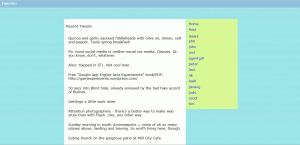07.07
When I was browsing /r/programming earlier this morning, I came
across a link to a web application named Tweeter. I played around with
it for a while and I think it’s a really awesome application, so I
figured I’d write a post about it. ![]()
Tweeter is a web application designed for a single purpose: to give people a chance to apply their knowledge of SQL injections to a “real” site. The attacker’s goal is to use his/her knowledge of SQL injections to post as an existing user named agentgill. Once the “hack” is complete, the attacker is directed to a new version of the website, designed with more safeguards and security measures that need to be circumvented. I don’t want to delve into the specifics of the different versions, but there are a total of four levels, each with their own set of challenges that must be overcome.
I really enjoyed playing with Tweeter. It was a fun challenge and it gave me a chance to reuse some basic SQL injection knowledge I haven’t used in a while. It reminded me a little bit of Jarlsberg, a similar application created by Google to teach people about possible attack vectors in web applications (but which does not demonstrate SQL injections, since it does not use SQL). I believe tools like Tweeter are integral in teaching web application security; learning about SQL injections in class is nowhere near the same experience as being able to exploit them properly on a real website. I’ll definitely be adding it to my bookmarks.
If you’d like to try it out for yourself, you can click on this link to create a new instance on the author’s site.
More information about Tweeter (including a link to download the source) can be found on the author’s blog.
